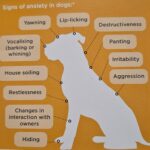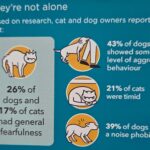YOUR PET DOESN’T SHOW THEIR MENTAL HEALTH CONCERN,
JUST AS HUMANS DON’T LIKE TO.
In the hustle and bustle of modern life, mental well-being is a significant concern for humans and our beloved pets. Just like us, pets can suffer from depression and anxiety, often exhibiting signs that can be easily overlooked. Understanding these symptoms and how to address them can make a difference in their lives and ours.
Based on research, cat and dog owners reported that:
43% of dogs showed some level of aggressive behaviour
21% of cats were timid
39% of dogs had a noise phobia
26% of dogs and 17% of cats had general fearfulness.
 Recognizing Symptoms of Depression and Anxiety in Pets
Recognizing Symptoms of Depression and Anxiety in Pets
Just like humans, pets can show various signs of mental distress. Here are some common symptoms to watch for:
Changes in Appetite: Noticeable weight gain or loss due to changes in eating habits.
Lethargy: A sudden lack of energy or interest in activities they used to enjoy.
Isolation: Hiding, avoiding interaction, or reluctance to be around people or other animals.
Excessive Grooming or Licking: Particularly in cats, this can be a sign of stress or anxiety.
Aggression: Uncharacteristic aggression towards people or other animals.
Vocalization: Excessive barking, whining, or meowing that is out of the ordinary.
Destructive Behavior: Chewing, scratching, or tearing up household items.
You can download our Pet Depression Checklist by clicking here.
Depression and Anxiety are not your pet’s fault.

Your pet may be fearful and anxious due to genetics and upbringing. Some pets are more prone to anxiety genetically than others. A past event in your pet’s upbringing may have implanted a fear or anxiety concerning a particular trigger, and changes in their lifestyle or living environment can make cats struggle to adapt or cope.
Solutions and Coping Strategies
Addressing depression and anxiety in pets involves a combination of environmental enrichment, physical activity, and, in some cases, professional help:
- Regular Exercise: Ensure your pet gets plenty of physical activity. For dogs, this might mean regular walks or playtime. For cats, interactive toys or climbing structures can be beneficial.
- Routine: Maintaining a consistent daily schedule can provide comfort and predictability.
- Mental Stimulation: Engage your pet with puzzles, training sessions, or new toys to keep their minds active.
- Comfort and Security: Provide a safe and cozy space where your pet can retreat and feel secure.
- Professional Help: Consult a veterinarian or a pet behaviourist if symptoms persist. They can offer guidance and, if necessary, medication. Our local go-to professional is The Westbrook Veterinary Surgery.
Drawing Parallels to Human Mental Health
Interestingly, the way pets express their mental struggles is quite similar to how humans might display symptoms of depression and anxiety. Just as pets can’t verbally express their distress, many people also struggle to communicate their mental health issues. This silent suffering highlights the importance of regular check-ins, not just with our pets but with our friends and loved ones.











An interesting read and really found the parallel between the signs of anxiety/depression for pets and people. In addition, the ameliorating actions were also similar eg regular exercise, stimulation and supportive environment. Well worth a read. Thank you.